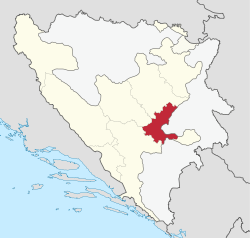Kanton Sarajevo
|
Sarajevo Canton Kanton Sarajevo Kanton Sarajevo (bs) Sarajevska županija (hr) Сарајевски кантон (sr) |
|||
|---|---|---|---|
| Canton | |||
|
|||
 Location of the Sarajevo Canton |
|||
| Coordinates: 43°51′N 18°15′E / 43.850°N 18.250°E | |||
| Country | Bosnia and Herzegovina | ||
| Entity | Federation of Bosnia and Herzegovina | ||
| Established | 1995 | ||
| Main city | Sarajevo | ||
| Municipalities |
List
|
||
| Government | |||
| • Prime minister | Elmedin Konaković | ||
| Area | |||
| • Total | 1,276.9 km2 (493.0 sq mi) | ||
| Population (2013 census) | |||
| • Total | 413,593 | ||
| • Density | 343.37/km2 (889.3/sq mi) | ||
| ISO 3166 code | BA-09 | ||
The Sarajevo Canton, officially the Canton of Sarajevo (Bosnian: Kanton Sarajevo,Croatian: Sarajevska županija, Serbian Cyrillic: Сарајевски кантон) is one of 10 cantons of the Federation of Bosnia and Herzegovina in Bosnia and Herzegovina. Its cantonal capital is Sarajevo, also the capital city of Bosnia and Herzegovina.
The Canton represents the metro area of the country's capital city, Sarajevo together with the City of East Sarajevo. It contains 97% of the city's population, but a much smaller percentage of the official land area. The majority of the population is Bosniak (83,8%).
The history of Sarajevo dates back to Neolithic times, when the Butmir culture made its mountains and hills their home. In ancient times, the Sarajevo area (Canton) was occupied by the Illyrians. The local tribe, the Daesitates, controlled most of the area. They were a warlike bunch and the last Illyrian tribe to resist Roman rule, which finally came in AD 9. Under Roman rule, many roads were constructed in the region, as well as a city on top of modern-day Ilidža. During the Middle Ages, the area of Sarajevo Canton was a key part of the Bosnian Kingdom. The toponym Vrhbosna existed somewhere in the region and was one of the notable settlements at the time.
True development of the region came after the Ottoman conquest when local Muslim noble Isa-Beg Isaković established the roots of the modern city of Sarajevo, between 1461 and 1463. The region grew along with the city, which quickly, after Istanbul, became the most important in the Balkans. Later rule by Austria-Hungary modernized and westernized the region. Under Yugoslavia, the Yugoslavian government further developed the area, which more than tripled in size. Much of this progress was offset however by the Yugoslav Wars in the early 1990s.
...
Wikipedia


